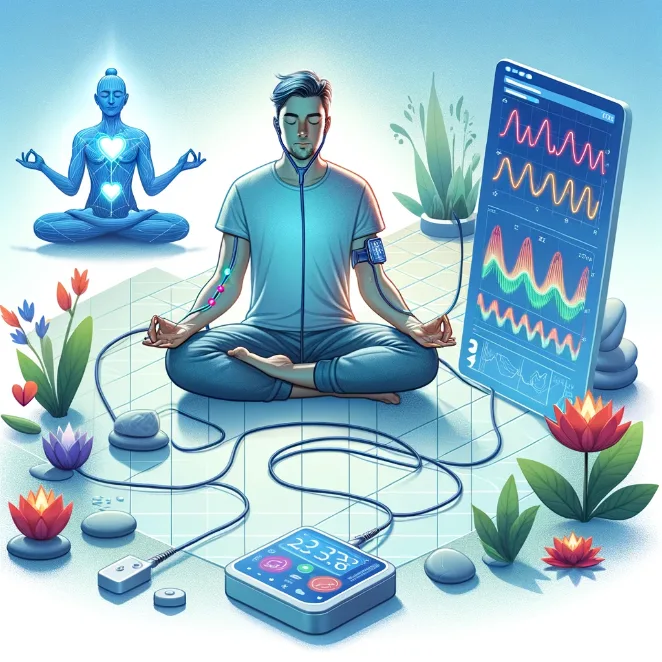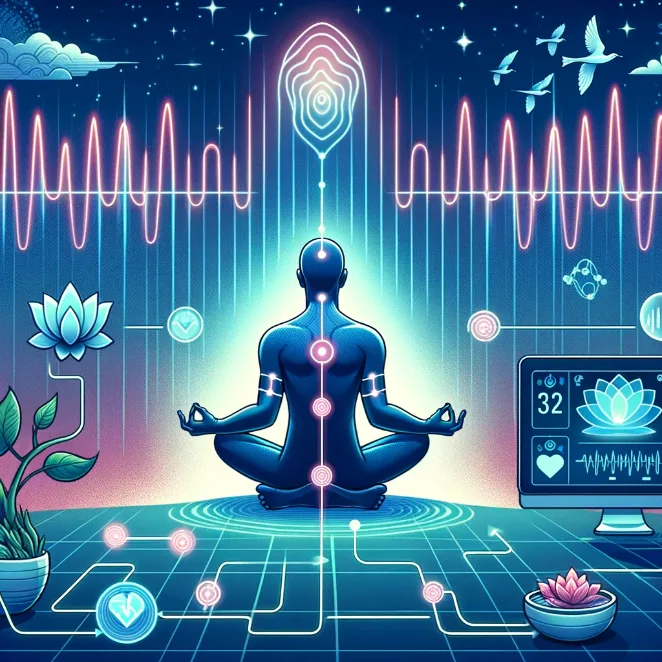
The Synergy Of Mindfulness & Technology
In the age of constant connectivity and digital distractions, the quest for inner peace and mindfulness remains a timeless pursuit. It's no wonder that individuals are increasingly turning to technology to aid them on this journey. Biofeedback, a cutting-edge technology that provides real-time data on physiological processes, is emerging as a powerful complement to traditional meditation practices. This article explores the fascinating synergy between biofeedback and meditation, shedding light on how these seemingly disparate worlds are converging to enhance mental well-being and self-awarenessю
article by Hina Kurosawa
Understanding Biofeedback
Harnessing the Body's Signals
Biofeedback is a process that enables individuals to gain awareness and control over physiological functions that are typically involuntary, such as heart rate, muscle tension, and skin temperature. This technology uses sensors to monitor these bodily processes and provides real-time feedback in the form of visual or auditory cues. By learning to interpret and manipulate these signals, individuals can influence their physical and mental states.

Meditation: A Path to Mindfulness
Ancient Wisdom for Modern Living
Meditation, rooted in ancient traditions, has been a cornerstone of mindfulness and self-discovery for centuries. It offers a pathway to inner peace, emotional resilience, and heightened self-awareness. Through various techniques like mindfulness meditation, loving-kindness meditation, and transcendental meditation, individuals learn to cultivate a focused and non-judgmental awareness of their thoughts and feelings.
The Marriage of Biofeedback and Meditation
Enhancing Mindfulness through Data
Biofeedback and meditation might seem like an unlikely pair, but they share a common goal: the cultivation of mindfulness. When combined, these practices form a symbiotic relationship. Biofeedback provides real-time data on physiological responses, offering individuals insights into their body's reactions to stressors and relaxation techniques. This data-driven approach can deepen one's meditation practice by making the mind-body connection tangible and actionable.

Benefits of Biofeedback-Enhanced Meditation
Empowering Self-Regulation
One of the key benefits of integrating biofeedback into meditation is enhanced self-regulation. By receiving immediate feedback on physiological parameters, individuals can make conscious adjustments to their meditation techniques. For example, if biofeedback reveals elevated heart rate and muscle tension during meditation, the practitioner can adapt their practice to induce a greater state of calm and relaxation.

Reducing Stress and Anxiety
Measurable Calmness
Stress and anxiety often manifest as physiological responses, such as increased heart rate and shallow breathing. Biofeedback can quantify the level of stress by tracking these physiological markers. Combining biofeedback with meditation allows individuals to develop targeted strategies for reducing stress and anxiety. By observing the immediate impact of relaxation techniques on biofeedback data, individuals gain confidence in their ability to manage stress.

Enhancing Mind-Body Connection
Fostering Awareness
Biofeedback-assisted meditation promotes a profound awareness of the mind-body connection. As individuals learn to manipulate their physiological responses through meditation, they develop a deep sense of control and agency over their well-being. This heightened awareness extends beyond meditation sessions, allowing individuals to apply mindfulness to various aspects of their lives.
A Harmony of Ancient Wisdom and Modern Science
The fusion of biofeedback and meditation exemplifies the harmony of ancient wisdom and modern science. By leveraging technology to deepen mindfulness practices, individuals can embark on a transformative journey of self-discovery and well-being. This partnership offers a tangible bridge between the inner world of consciousness and the external world of data, empowering individuals to become active participants in their mental and physical health.
Published: 12/5/2023
Modified: 12/5/2023
More predictions
Come back here soon to learn more about yourself and your future


Harnessing Meditation For Stress Relief & Relaxation
Discover the nuances of meditation as a practice for relaxation and how it transcends basic stress relief techniques.


Meditation's Impact On Learning & Education
In the world of education, the quest for effective learning techniques is a never-ending journey. Teachers, parents, and students alike are constantly seeking ways to enhance the learning experience. In recent years, meditation has emerged as a powerful tool that not only reduces stress but also positively impacts learning and education. This article explores the various ways in which meditation can transform the educational landscape, from improving concentration and memory to fostering emotional intelligence and creativity.


Meditation In Holistic Nursing: Nurturing Body, Mind, & Spirit
Holistic nursing is an approach that recognizes the interconnectedness of body, mind, and spirit in the pursuit of optimal health and healing. It goes beyond conventional medical care to embrace complementary practices that nurture the whole person. Among these practices, meditation stands as a cornerstone, offering holistic nurses and their patients a powerful tool for promoting wellness, managing illness, and fostering spiritual growth.